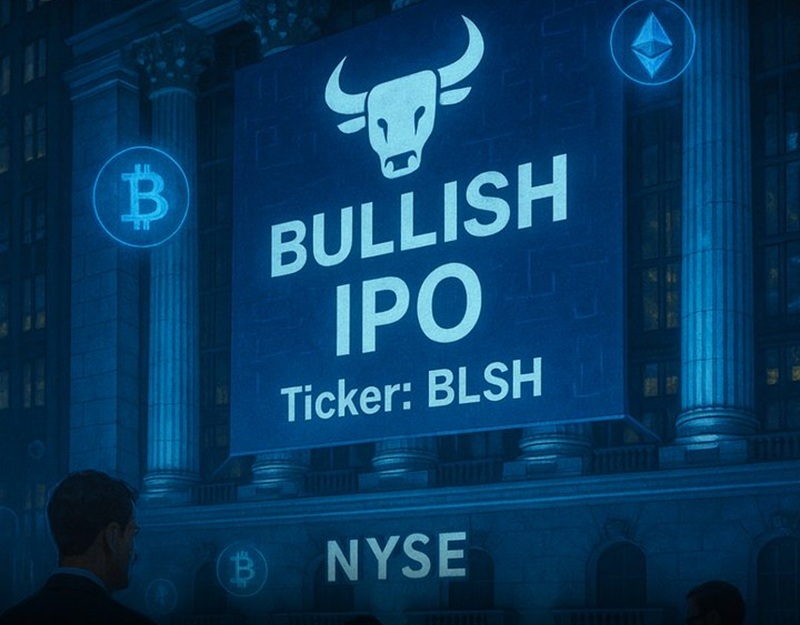Bullish Files for IPO as Trump’s Crypto Embrace Sends Bitcoin and Industry Valuations Soaring

Bullish, the cryptocurrency exchange backed by billionaire Peter Thiel, filed for an initial public offering (IPO) on Friday, joining a wave of digital asset firms heading to public markets amid renewed investor enthusiasm and unprecedented political support for the industry.
The filing, submitted to the U.S. Securities and Exchange Commission (SEC), marks a critical moment for Bullish and the broader crypto sector, which has long sought regulatory clarity and mainstream legitimacy. The company plans to list its shares on the New York Stock Exchange under the ticker “BLSH.”
Bullish is led by Tom Farley, a veteran of traditional finance and former president of the New York Stock Exchange, and was spun out of Block.one in 2021 with backing from Thiel’s Founders Fund and Thiel Capital, along with investors such as Nomura, Mike Novogratz, and other institutional players. In 2023, Bullish expanded into crypto media by acquiring CoinDesk, further deepening its footprint in the digital asset ecosystem.
Register for Tekedia Mini-MBA edition 18 (Sep 15 – Dec 6, 2025) today for early bird discounts. Do annual for access to Blucera.com.
Tekedia AI in Business Masterclass opens registrations.
Join Tekedia Capital Syndicate and co-invest in great global startups.
Register to become a better CEO or Director with Tekedia CEO & Director Program.
In its filing, Bullish reported an average daily trading volume of over $2.5 billion in the first quarter of 2025, ranking it among the top five global exchanges for Bitcoin and Ether spot volume. Since its launch, the platform has executed more than $1.25 trillion in cumulative trades, underscoring its rapid growth and rising stature among crypto market leaders like Binance, Coinbase, and Kraken—all named as competitors in its prospectus.
But Bullish’s timing is especially notable. Its IPO filing came just hours after President Donald Trump signed the GENIUS Act into law—a sweeping piece of legislation that establishes a regulatory framework for stablecoins, the blockchain-based tokens tied to fiat currencies like the U.S. dollar.
The bill, passed by Congress during a week of pro-crypto legislative momentum branded as “Crypto Week,” has been hailed by industry stakeholders as a foundational step toward legitimizing digital assets in the U.S. financial system. It sets out requirements for 1:1 fiat backing, audits, and licensing structures, enabling companies like Bullish to operate in a more predictable regulatory environment.
The impact was immediate. Within 24 hours of Trump signing the GENIUS Act, Bitcoin surged to an all-time high of $122,838, while the entire crypto market capitalization climbed to $2.4 trillion, briefly surpassing Amazon to become the fifth-largest asset class in the world. The GENIUS Act, combined with other crypto-friendly bills such as the CLARITY Act and the Anti-CBDC Surveillance State Act, formed a trio of laws aimed at integrating digital assets into the American economy while shielding it from unwanted government overreach.
Bullish explicitly echoed this agenda in its SEC filing, stating that its mission is to “drive the adoption of stablecoins, digital assets, and blockchain technology,” a nod to the regulatory tailwinds now reshaping the industry’s trajectory.
The sector’s resurgence has been fueled not only by legislation but also by direct political backing from President Trump, who has emerged as an outspoken champion of crypto. His administration has staffed top roles with tech-aligned figures such as David Sacks, now serving as Trump’s AI and Crypto czar, and aligned closely with billionaire allies, including Elon Musk and Peter Thiel, all of whom have actively supported his re-election bid and legislative agenda.
Trump’s approach has sharply diverged from the regulatory stance of previous administrations, which emphasized enforcement actions and risk containment. Instead, the Trump White House has opted for integration—bringing crypto into the mainstream financial fold and offering it the legal certainty that investors have demanded for years.
Bullish is not alone in seizing the moment. Circle, the issuer of USDC, saw its stock surge more than sevenfold after its June IPO. Etoro, the online trading platform with crypto services, went public in May, and Galaxy Digital, founded by Novogratz, transitioned its listing from the Toronto Stock Exchange to the Nasdaq that same month. Gemini, the exchange run by the Winklevoss twins, also filed confidentially for an IPO in June.
Meanwhile, Bitcoin, the industry’s bellwether, is up nearly 30% this month alone, and over 100% since July 2024—an explosive rally that analysts attribute to the policy clarity, institutional inflows, and growing belief that crypto is now on the path to permanent integration into the financial system.
As Bullish prepares to go public, it will do so in a market environment more favorable than any crypto firm has previously enjoyed. With strong backing, massive volumes, and a seasoned Wall Street executive at its helm, Bullish appears poised to become a pillar of the newly legitimized digital asset economy.
And with the White House and Capitol Hill now in sync with Silicon Valley’s most powerful crypto evangelists, the exchange is entering a public market where momentum—and the presidency—are on its side.


